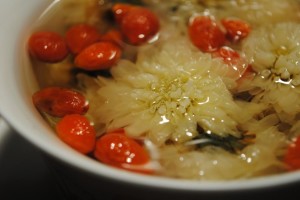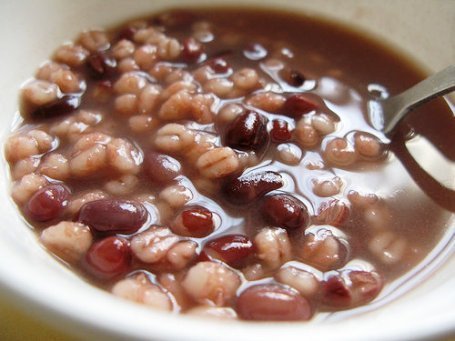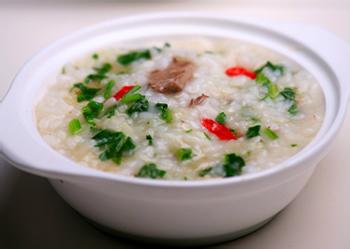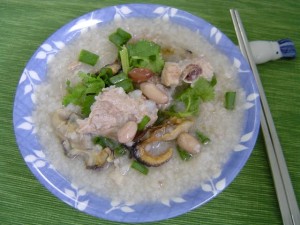In a previous post I wrote about the history of the Chinese Medicated Diet in Traditional Chinese Medicine. In this post, I’m going to write very briefly about Traditional Chinese Medicine and eye health, then cover five different Chinese Medicated Diet Recipes for Eye Health. In Traditional Chinese Medicine, although all the organs have some relations to the eyes, the liver meridian is connected to the eyes. Therefore many Chinese herbs for eye also nourish the liver. Chinese herbs can treat blurred vision, improve night vision, slow the progression of glaucoma and cataracts and help keep the eyes healthy. Within TCM, there are a variety of Herbs and Foods that support eye health and the following recipes include a number of these. This Post will concentrate on the Recipes themselves, while a subsequent post will provide an overview on TCM theory and the Eyes.
Goji Berry Tea with Mulberry and Chrysanthemum
Goji Berry, Mulberry and Chrysanthemum Tea is one of those recipes that has been used within Traditional Chinese Medicine since time immemorial. This tea is a classic herbal mixture to improve vision and protect eyesight. The combination of these 3 herbal ingredients helps eliminate heat from the liver, nourishing the blood and yin and thereby protecting the eyes from free radical damage. Long term consumption can brighten the eyes (and also for supporting general health).
More recent research tells us that Goji Berry contains large amount of Vitamin C which is one of the most important anti-oxidants. Goji Berry also high levels of zeaxanthin, lutein, polysaccharides and polyphenols, which have been shown to improve eyesight, prevent macular degeneration and also prevent diabetic retinopathy. Chrysanthemum is slightly cool and clears heat from the liver (and in Traditional Chinese Medicine, is one of the most commonly used herbs in the treatment of eye disorders). Chrysanthemum also contains beta-carotene and is a good source of Vitamin B’s. Mulberry is rich in iron and contains powerful antioxidants. Jujube Date is warm. It tonifies Spleen, reinforces Qi, nourishes blood and calm the mind.
Without knowing these facts however, Traditional Chinese Medicine had determined empirically, many centuries ago, that the combination of these herbs were beneficial for the eyes and for the treatment of eye disorders. Modern research once again supports the findings of the ancient wisdom of Traditional Chinese Medicine.
Ingredients
- 15 grams Goji Berry
- 15 grams dried White Mulberry
- 5-10 grams dried Chrysanthemum Flower
- 1 piece of Big Jujube Date, sliced open (Optional)
- 3 Cups Water
Procedure
- Bring the water to a boil in a pot
- Add all ingredients to the boiling water
- Turn off heat. Cover with a lid. Let infuse for 10-15 minutes
- Strain the tea to remove the berries and flowers
- Serve warm. Do not add honey.
Beef Liver and Onion Stir-fry
In Traditional Chinese Medicine, the Liver Meridian is connected to the eyes, with the eyes seen as the outward orifices of the Liver. And in fact, of the twelve meridians, only the liver meridian is directly connected with the eyes. Therefore, eye problems may indicate that the Liver Meridian or the Liver organ itself is out of balance. And in the Ancient Chinese Medical Texts, the organ of an animal to treat the organ that is out of balance and its associated meridian is often prescribed. Therefore, Liver is traditionally used as part of a Chinese Medicated Diet to treat eye problems.
Now what’s so special about Liver that Traditional Chinese Medicine uses Liver and Onion Stir-fry as a treatment for the eyes? And has done so for many centuries. Well, we again find that modern scientific research supports Traditional Chinese Medicine. It turns out that Beef Liver is high in Vitamin A, including retinol, an active form of Vitamin A that is only found in meat. And Rhodopsin is a protein in the eye that contains a retinal compound. Without Rhodopsin, vision may be impaired and night-blindness may occur. Besides night-blindness, too little Rhodopsin may also lead to xeropthalmia, an abnormal dryness of the eyeball that is characterized by conjunctivitis. Rhodopsin can only be synthesized by the body if Vitamin A is present in the diet. And interestingly enough, the best animal source of Vitamin A is Liver. Once again we find that Traditional Chinese Medicine, many centuries ago and without being aware of Vitamin A or of Rhodopsin, had empirically identified Liver as a remedy for eye problems.
Ingredients
- 1 lb Beef/Lamb Liver
- 1 Onion
- 3/4 Cup Milk
- 1/8 Cup Butter
- 1 Cup Flour
- Salt and Black Pepper to taste
Procedure
- Slice liver thinly
- Gently rinse liver slices under cold water and place in a medium bowl. Pour enough milk to cover. Soak for 1-2 hours to eliminate bitter taste of the liver
- Slice Onion into rings
- Melt 2 tablespoon of butter in a large skillet over medium heat. Saute onion in butter until soft. Remove from skillet
- Add remaining butter to the skillet
- Season flour with salt and pepper in a bowl. Put the liver (drained) into the dish and coat slices in the flour mixture
- When the butter has melted, turn the heat up to medium-high and cook coated liver slices in the pan until brown.
- Add Onion to the liver. Saute until it is fully cooked. Enjoy!
Serves 4. Preparation Time 20 minutes (approx.). Cooking Time 20-25 minutes (approx.)
Also, a couple of variations. You can add Goji Berries to this recipe – simply soak 20 grams of Goji Berries for 10 to 15 minutes in water before starting to cook, then add to the stir-fry when the liver is almost fully cooked. You can also use soy sauce and ginger and add to taste when cooking.
Chinese Adzuki and Chinese Barley Tea (contraindicated during pregnancy)
This tea contains the 2 most common ingredients used to eliminate dampness in the body. It is not specifically for the eyes. However, it is suitable for those with a warm constitution and dampness retention manifested in yellowing and cloudiness of the sclera, diarrhea or loose stool (or with pus in stool), swelling, stiffness sensation of the joints, sluggishness and being overweight etc. Drink the tea and discard the pulp. Long term consumption can strenghtn digestion, lighten the body and improve circulation. DO NOT ADD RICE TO COOK OR IT RUINS THE DAMP ELIMINATION FUNCTION OF THIS TEA!
The recipe below makes enough for 3 servings. Cooking time is 20 minutes, after which the tea should be left in a thermal container to sit for 6 hours before drinking. Don’t drink chilled adzuki bean and barley tea and don’t microwave the tea. You can consume the tea at room temperature (warm) or heat it up on the stove. Don’t add sweetener, but if you like you can add a pinch of sea salt. There’s no particular best time of the day to drink the adzuki bean and barley tea, but for general good health you can drink this daily for four to five days per week on an ongoing basis.
Adzuki beans are extremely nutritious, stuffed with protein, and contain calcium, iron, niacin, phosphorus, riboflavin, thiamine, and folate (water-soluble B vitamin). Unlike lots of medicinal beverages which are usually bitter, adzuki and barley tea is bland, although you should make sure you strain the beans out just before consuming the tea. The Adzuki beans can be a bit tough to chew! We normally discard it unless the beans are left to cook for hours in the pot before serving. BOTH ADZUKI BEAN AND CHINESE BARLEY ARE CONTRAINDICATED DURING PREGNANCY, DO NOT DRINK IF YOU ARE PREGNANT OR WANTING TO CONCEIVE.
Ingredients
- 30 grams Chinese Barley
- 30 grams Chinese Adzuki Bean
- 5 Cups Water
Procedure
- Wash the beans
- In a pot, add all ingredients and cook at high heat for 20 minutes
- Do not strain out the beans and pulp
- Transfer the tea to a thermos flask or heat-retaining pot. Store for 5-6 hours, then filter, serve and drink warm
- Makes 3 Servings
Liver Congee with Goji Berry
Congee is a thick rice porridge made from rice boiled in a large amount of water until it softens significantly. Besides being an everyday meal eaten widely throughout China, congee is often used as part of a medicated diet for the unwell. Ingredients are determined by their therapeutic value as well as flavor. In the case of Liver Congee with Goji Berry, we have already seen how both Liver and Goji Berry are beneficial for the eyes. This recipe combines both these ingredients with a soft and easily eaten rice porridge which can be consumed at any time of the day.
Ingredients
- 1/4 lb Liver
- 100 grams Rice (not cooked / not instant)
- 4 Cups Water
- 1 small green onion, finely chopped
- 1/4 inch of fresh Ginger root, minced
- 15 grams Goji Berry
- 1/2 teaspoon Sea Salt
Procedure
- Rinse the Liver thoroughly, then slice and dice. Mix with minced Ginger and set aside
- In a pot, add water, bring to the boil, add rice and simmer for 20 minutes
- Add liver/minced finger and Goji Berry to the rice mixture. Simmer for 10 minutes until the liver is just cooked
- Turn off heat, add Green Onion and sea salt to taste
- Serve warm.
Oyster Congee
This is another Congee recipe, but this time the main medicated diet ingredient is Oysters, a food ingredient that has been used in medicated diets in China for many centuries. Oysters are naturally high in many essential vitamins and minerals including iron, omega 3 fatty acids, calcium, zinc, selenium, potassium, magnesium, Vitamin B-12 and Vitamin C.
Of these, Vitamin B-12 is particularly helpful in cases of light sensitivity. Deficiency in Vitamin B12 can lead to Optic Neuropathy and decreased vision. Some researchers have also found that increased in Vitamin B-12 supplementation improves symptoms and conditions of glaucoma. Other age-related disease such as Macular Degeneration and cataracts may also be due to a deficiency in Vitamin B12. Vitamin C works synergistically with other anti-oxidant such as Selenium. A deficiency in Vitamin C may be one of the most common cause of cataract formation.
Oysters are particularly high in Selenium. In a study that involved rats, a diet that deprived the rats of Selenium has shown an increased incidence of cataract formation. Clinical studies showed that Selenium has a protective role in development of cataract, macular degeneration, retinitis pigmentosa and other ocular diseases. Zinc works together with Vitamin A to help sense light and transmit the nerve impulses to the brain. A study that was published on October 12, 2001 by the National Eye Institute showed that a high level of zinc and other antioxidants can reduce the risk of advanced age-related macular degeneration (AMD) and its associated vision loss. A serving of oysters contains more Zinc than any other food per serving (76.7mg in 6 medium oysters!). This is more than 100% of the suggested daily amount of 8-11mg. Because your body has no natural way to store zinc, it’s important to make sure you’re getting your daily dose.
Ingredients
- 1 cup Oysters
- 1 cup medium grain Brown Rice (not cooked / not instant)
- 2 Tablespoons Roasted Peanuts
- 2 Tablespoons finely chopped Carrot
- 1/2 Celery Stalk, finely chopped
- 1 teaspoon dried Kelp, soak in water. Cut into fine strips.
- 1 Teaspoon minced fresh Ginger
- 1 tablespoon green onion, finely chopped
- 1/2 teaspoon Sesame Oil
- 5-6 cups Water
Procedure
- Rinse the Oyster thoroughly. Mix whole Oysters with minced Ginger and set aside
- In a pot, add water, bring to the boil, add rice and simmer for 30 minutes or until rice is softened.
- Add Oyster, carrot, celery, kelp to the rice mixture. Simmer for 8-10 minutes until the Oyster is just cooked
- Turn off heat, add Green Onion, peanut, sesame oil and sea salt to taste
- Serve warm.
Thankyou for reading and I hope you enjoy these recipes
……………..Bernadette
 Copyright secured by Digiprove © 2014
Copyright secured by Digiprove © 2014 



